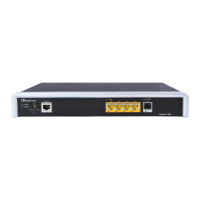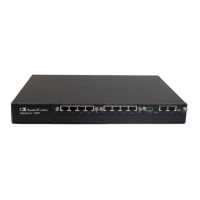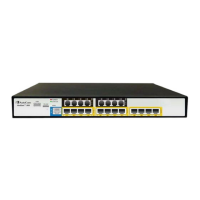Version 7.0 907 Mediant 3000
User's Manual 58. Configuration Parameters Reference
Parameter Description
The Retry-After header is used with the 503 (Service Unavailable)
response to indicate how long the service is expected to be unavailable
to the requesting SIP client. The device maintains a list of available
proxies, by using the Keep-Alive mechanism. The device checks the
availability of proxies by sending SIP OPTIONS every keep-alive timeout
to all proxies.
If the device receives a SIP 503 response to an INVITE, it also marks
that the proxy is out of service for the defined "Retry-After" period.
Enable P-Associated-URI
Header
[EnablePAssociatedURIH
eader]
Determines the device usage of the P-Associated-URI header. This
header can be received in 200 OK responses to REGISTER requests.
When enabled, the first URI in the P-Associated-URI header is used in
subsequent requests as the From/P-Asserted-Identity headers value.
[0] Disable (default)
[1] Enable
Note: P-Associated-URIs in registration responses is handled only if the
device is registered per endpoint (using the User Information file).
Source Number
Preference
[SourceNumberPreferenc
e]
Determines from which SIP header the source (calling) number is
obtained in incoming INVITE messages.
If not configured or if any string other than "From" or "Pai2" is
configured, the calling number is obtained from a specific header
using the following logic:
a. P-Preferred-Identity header.
b. If the above header is not present, then the first P-Asserted-
Identity header is used.
c. If the above header is not present, then the Remote-Party-ID
header is used.
d. If the above header is not present, then the From header is used.
"From" = The calling number is obtained from the From header.
"Pai2" = The calling number is obtained using the following logic:
a. If a P-Preferred-Identity header is present, the number is
obtained from it.
b. If no P-Preferred-Identity header is present and two P-Asserted-
Identity headers are present, the number is obtained from the
second P-Asserted-Identity header.
c. If only one P-Asserted-Identity header is present, the calling
number is obtained from it.
Notes:
The "From" and "Pai2" values are not case-sensitive.
Once a URL is selected, all the calling party parameters are set from
this header. If P-Asserted-Identity is selected and the Privacy header
is set to 'id', the calling number is assumed restricted.
[SelectSourceHeaderForC
alledNumber]
Determines the SIP header used for obtaining the called number
(destination) for IP-to-Tel calls.
[0] Request-URI header = (Default) Obtains the destination number
from the user part of the Request-URI.
[1] To header = Obtains the destination number from the user part of
the To header.
[2] P-Called-Party-ID header = Obtains the destination number from
the P-Called-Party-ID header.
Enable Reason Header Enables the usage of the SIP Reason header.

